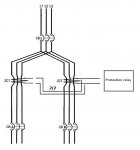Mousa
Member
- Location
- Amman, Jordan
Hello friends
I have a strange case that I would like to share with you and take your advice
I have a MV switchgear divided in two sections (A&B) and a Tie breaker between them
each section has a feeding breaker
The strange side that both feeders of the switchgear will be connected to one breaker (one breaker supplying power to two breakers) ... actually this is the provided design and it is out of my scope.
a zero sequence CT shall be connected on the outgoing cables (6 cables) of the source breaker for earth fault protection , but as i mentioned before the 6 cables will be divided, each three cables will go to breaker
the cables size is 630 mm2 and the provided CT is not enough to put 6 cable inside (the CT inner diameter is 200mm), so can two CTs be used ( one CT for each circuit) and connect the CTs secondary together then to the protection relay ??!

Please advice and do not hesitate to ask if the subject is unclear
I have a strange case that I would like to share with you and take your advice
I have a MV switchgear divided in two sections (A&B) and a Tie breaker between them
each section has a feeding breaker
The strange side that both feeders of the switchgear will be connected to one breaker (one breaker supplying power to two breakers) ... actually this is the provided design and it is out of my scope.
a zero sequence CT shall be connected on the outgoing cables (6 cables) of the source breaker for earth fault protection , but as i mentioned before the 6 cables will be divided, each three cables will go to breaker
the cables size is 630 mm2 and the provided CT is not enough to put 6 cable inside (the CT inner diameter is 200mm), so can two CTs be used ( one CT for each circuit) and connect the CTs secondary together then to the protection relay ??!

Please advice and do not hesitate to ask if the subject is unclear
